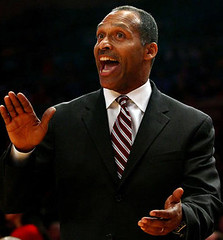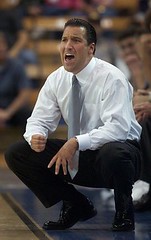(Original and longer version at the East Coast Bias.)
It’s been a 7 years since we’ve seen Steve Lavin coach the game of basketball. His UCLA squads were curious teams, playing various styles during his tenure with decent but not dominating success. The Bruins frustrated fans with NBA level talent but no Pac-10 conference titles, and with unexpected regular season defeats followed by sudden runs in the NCAA Tournament.
What was going on over there? How were the Bruins so frustrating? How was Lavin’s team superior to the Red Storm, and how were they similar?

 Here is a look at the average of UCLA’s season-ending results* with those numbers compared to Norm Roberts’ last 3 seasons at St. John’s to get a sense of what might be stylistically different between Lavin’s teams and Roberts’ teams.
Here is a look at the average of UCLA’s season-ending results* with those numbers compared to Norm Roberts’ last 3 seasons at St. John’s to get a sense of what might be stylistically different between Lavin’s teams and Roberts’ teams.
I use the last 3 seasons because those are seasons where Roberts had a full roster of players, so the numbers won’t be skewed by the player and recruit-decimated squads of his first 2+ years. I stay with in-conference stats to compare the two coaches’ results in games against their peers.
Note that with 7 years remove from competitive coaching, a completely different conference and coaching staff, and a squad that he didn’t recruit, this is not a solid predictor of what Steve Lavin’s teams will do. But it will give us insight into the speed and style of Steve Lavin’s early work.
* This is not an average of all the numbers, an average of the numbers/ finishes at the end of the season. The two results are only slightly different, and this approach is admittedly slightly less time-consuming for our purposes.
[table id=115 /]
Three Takeaways
On the plus side, Lavin’s UCLA teams were fast. They put up shots – the scoreboard didn’t get cheated. And the teams scored decently from all over the floor. So first and foremost, I would expect to see Steve Lavin up the pace with St. John’s and use the athleticism that has been there. From top to bottom, the Red Storm has athletes who may just be better running; Sean Evans’ halfcourt game, for example, is less impressive than his speed at his size. Their crispness in the halfcourt leaves some to be desired, so getting the team to run may help St. John’s put up points with more consistency (and please the fans who want to see some exciting ball).
On the negative side is the defense of Lavin’s teams in Westwood. Between the extra free throws at the high pace (meaning more attempts) and the extra three-point shots, you can see why UCLA tended to give up bunches of points. And those defensive breakdowns are not evenly spread over the season; those problems sometimes come to rear their head in different games. One game was a flurry of three-pointers from Stanford. Another, a parade of free throws from Arizona State. Yet another would be a post beating and dunkfest from Fred Jones and Oregon. Consistency of scheme and effort will be necessary, and the staff will need to work on core concepts to stop the other team from scoring.
Lastly, rebounding in a fast-paced game is different than rebounding in a slower paced game. It is harder to find the opponent and put a body on them. Defenses have to set up and adjust more quickly, and rebounders have to look to finish the possession on both ends. UCLA’s teams needed to be better at rebounding the ball on the defensive end. And St. John’s tenacity at defensive rebounding cannot be lost to the freedom of running.
For more detail, see the bullet points below.
Pace
- Wait ’til halftime for the popcorn: As mentioned, UCLA played faster than St. John’s. Lavin’s teams played at a pace that rivaled the fastest teams in college basketball this year – faster than Kansas State and even Texas, and similar to Providence.
- I went for popcorn and THIS happened: A faster pace means losses become blowouts that much more quickly, and give the other team extra chances to score. The blowouts UCLA suffered should be seen in the context of a game with a lot of shot attempts – they may not be as terrible as the scores indicate. Similar to Providence.
- It will look fun: At the very least, fans will enjoy watching a faster style, and hopefully fewer of those games like last year’s St. John’s/ Cincinnati sludge fest.
Scoring Offense
- The Western version: Stylistically, both teams attempted to score inside and generally avoided outside shooting, choosing to win with athleticism/ drives to the hoop instead of the jump shot.
- Guaranteed points! Most of the time: Lavin’s teams scored a lot of points in Westwood. Despite some inconsistency in their outside shooting – especially when Jason Kapono was the only reliable sharpshooter – the Bruins consistently got points inside the arc.
- Guaranteed droughts! Much of the time: Norm Roberts’ teams did not score a lot of points; the Red Storm has been a poor shooting team, especially inside the arc, for years.
Scoring Defense
- Beatdown in the middle: On defense, the Red Storm couldn’t stop opponents’ scoring inside the arc.
- The arc was open: UCLA’s opponents took more shots from beyond the three-point line (lower percentage shots). Despite shooting a lower percentage, they scored more points from long distance than UCLA did.
- Questionable interior defense: 48.8% is not a great defensive number for mid-range/ interior defense from UCLA.
- Three points are better than two: To win playing an interior-focused style on offense, the defense needs to limit the other teams’ number of outside attempts, or dominate in defending 2-point attempts. UCLA was good enough to win games when the offense worked, but not good enough to dominate the Pac-10.
- Onto the bubble?: If Lavin can approach UCLA’s level of offensive efficiency inside the paint, the team will compete. If he can improve on St. John’s defensive efficiency as well, St. John’s will go to the NCAA Tournament next year.
Rebounding
- Fewer putbacks: St. John’s was a slightly inferior offensive rebounding unit to Lavin’s teams.
- The Red Storm cleaned the glass: Norm Roberts’ squads were far better defensive rebounders, while UCLA was actually fairly bad at ending the other team’s possession.
- Get the ball: Second chance points can kill even the most talented teams. A good defense has to end possessions if they don’t want to give up points.
Turnovers/ Assists/ Shot Blocking
- Didn’t even have a chance to miss: St. John’s scoring deficiencies were exacerbated by their turnovers – they didn’t give themselves enough chances to score. The Red Storm was often on the losing side of the turnover battle.
- Just as much butter on the fingers: UCLA’s offensive turnover percentage was actually fairly similar.
- Just as much butter, but more: Given the faster pace of the Bruins, that means they turned the ball over more times in each game than St. John’s did.
- The other team also looked bad: In their defense, the Bruins also forced a good number of turnovers, keeping the turnover balance a little better than even.
- Where was the pass going…?: UCLA had more unforced/ unstolen turnovers – things like throwing the ball away, etc.
- A little sharing?: There are similarities in the assist rates on offense. UCLA scored off of individual play, not the flow of passes. St. John’s did as well, but their players were much less able to get quality shots from their individual drives.
- Ok, you can keep the ball, fine: Some of UCLA’s most ridiculous losses came when the Bruins could not force a turnover; with the mediocre defense, not forcing turnovers can be destructive for a basketball.
Free Throw Rate
- And none: The Red Storm have not drawn fouls at a high rate, despite the attempts at driving inside. This year, DJ Kennedy and Justin Burrell got to the line in conference play somewhat frequently as a percentage of their shot attempts. But no one else did.
- Share the free throw line: UCLA’s teams got to the line a decent amount on offense. But they allowed too many free throws, though that seemed more of a problem earlier on in Lavin’s career in Westwood. NOT sending players to the line (along with mediocre defense) could indicate lax defense or porous pressing + trapping.
- Frustration is a missed “free” opportunity: Both teams shot around a woeful 64.7% in their average year from the free throw line.
Transplanted New Yorker and now Midwesterner Peter a/k/a Pico writes for the East Coast Bias and the Church of Bracketology and for Johnny Jungle, doing the Calm Before the Storm posts. Pico is also on Twitter, @ECoastBias.

Leave a Reply
You must be logged in to post a comment.